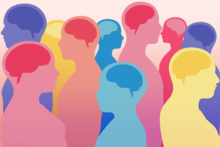The term neurodiversity refers to variation in the human brain regarding sociability, learning, attention, mood and other mental functions. It was coined in 1998 by sociologist Judy Singer, who helped popularize the concept along with journalist Harvey Blume. It emerged as a challenge to prevailing views that certain neurodevelopmental disorders are inherently pathological and instead adopts the social model of disability, in which societal barriers are the main contributing factor that disables people. This view is especially popular within the autism rights movement. The subsequent neurodiversity paradigm has been controversial among disability advocates, with opponents saying that its conceptualization doesn't reflect the realities of individuals who have high support needs.
History
The word neurodiversity is attributed to Judy Singer, a social scientist who has described herself as "likely somewhere on the autistic spectrum" and used the term in her sociology honors thesis published in 1999. The term represented a move away from previous "mother-blaming" theories about the cause of autism. Singer had been in correspondence with Blume as a result of their mutual interest in autism, and though he did not credit Singer, the word first appeared in print in an article by Blume in The Atlantic on September 30, 1998.
Some authors also credit the earlier work of autistic advocate Jim Sinclair in advancing the concept of neurodiversity. Sinclair was a principal early organizer of the international online autism community. Sinclair's 1993 speech, "Don't Mourn For Us", emphasized autism as a way of being: "It is not possible to separate the person from the autism." In a New York Times piece written by American journalist and writer Harvey Blume on June 30, 1997, Blume described the foundation of neurodiversity using the term "neurological pluralism". Blume was an early advocate who predicted the role the Internet would play in fostering the international neurodiversity movement.
The term "neurodiversity" has since been applied to other conditions and has taken on a more general meaning; for example, the Developmental Adult Neurodiversity Association (DANDA) in the UK encompasses developmental coordination disorder, ADHD, Asperger's syndrome, and related conditions.
Within disability rights movements
The neurodiversity paradigm was taken up first by individuals on the autism spectrum. Subsequently, it was applied to other neurodevelopmental conditions such as ADHD, developmental speech disorders, dyslexia, dyspraxia, dyscalculia, dysnomia, intellectual disability and Tourette syndrome, as well as schizophrenia, and some mental health conditions such as bipolarity, schizoaffective disorder, antisocial personality disorder, dissociative disorders, and obsessive–compulsive disorder. Neurodiversity advocates denounce the framing of autism, ADHD, dyslexia, and other neurodevelopmental disorders as requiring medical intervention to "cure" or "fix" them, and instead promote support systems such as inclusion-focused services, accommodations, communication and assistive technologies, occupational training, and independent living support. The intention is for individuals to receive support that honours authentic forms of human diversity, self-expression, and being, rather than treatment which coerces or forces them to adopt normative ideas of normality, or to conform to a clinical ideal.
Proponents of neurodiversity strive to reconceptualize autism and related conditions in society by the following measures: acknowledging that neurodiversity does not require a cure; changing the language from the current "condition, disease, disorder, or illness"-based nomenclature and "broaden[ing] the understanding of healthy or independent living"; acknowledging new types of autonomy; and giving non-neurotypical individuals more control over their treatment, including the type, timing, and whether there should be treatment at all.
A 2009 study separated 27 students (with autism, dyslexia, developmental coordination disorder, ADHD, and stroke), into two categories of self-view: "a 'difference' view—where neurodiversity was seen as a difference incorporating a set of strengths and weaknesses, or a 'medical/deficit' view—where neurodiversity was seen as a disadvantageous medical condition." They found that, although all of the students reported uniformly difficult schooling careers involving exclusion, abuse, and bullying, those who viewed themselves from a difference view (41% of the study cohort) "indicated higher academic self-esteem and confidence in their abilities and many (73%) expressed considerable career ambitions with positive and clear goals." Many of these students reported gaining this view of themselves through contact with neurodiversity advocates in online support groups.
A 2013 online survey, which aimed to assess conceptions of autism and neurodiversity, found that "a deficit-as-difference conception of autism suggests the importance of harnessing autistic traits in developmentally beneficial ways, transcending a false dichotomy between celebrating differences and ameliorating deficit."
Neurodiversity advocates point out that neurodiverse people often have exceptional abilities such as hyperfocus alongside their deficits. In particular, autistic people may have exceptional memory or even savant skills. In the autistic population, even those without savant skills are more likely than those in the general population to have exceptional knowledge or abilities in narrow domains.
Controversy
The neurodiversity paradigm is controversial in autism advocacy. The dominant paradigm is one which pathologizes human brains that diverge from those considered typical. From this perspective, these brains have medical conditions which should be treated.
A common criticism is that the neurodiversity paradigm is too widely encompassing and that its conception should exclude those whose functioning is more severely impaired. Autistic advocate and interdisciplinary educator Nick Walker offers the distinction that neurodivergencies refer specifically to "pervasive neurocognitive differences" that are "intimately related to the formation and constitution of the self," in contrast to medical conditions such as epilepsy.
Neurodiversity advocate John Elder Robison agrees that neurological difference may sometimes produce disability, but at the same time he argues that the disability caused by neurological difference may be inseparable from the strengths it provides. "99 neurologically identical people fail to solve a problem, it’s often the 1% fellow who’s different who holds the key. Yet that person may be disabled or disadvantaged most or all of the time. To neurodiversity proponents, people are disabled because they are at the edges of the bell curve; not because they are sick or broken." He therefore argues for the accommodation of neurological difference, while also recognizing that it can produce disability.

